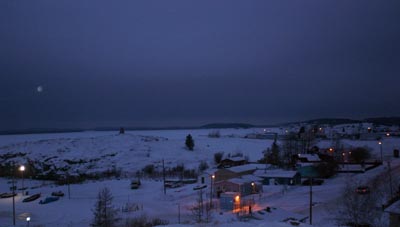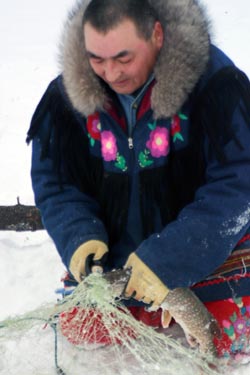BARB MARTOWSKI
 Founded in 1788, the village of Fort Chipewyan which is located on the shores of Lake Athabasca, started life out as a trading post for the North West Company. BARB MARTOWSKI/SnowSeekers |
FORT CHIPEWYAN, AB — Located 280 kilometres north of Fort McMurray, Fort Chipewyan (or Fort Chip as many call it) is Alberta's oldest European settlement. Established in 1788 by the North West Company, it's location on the northwestern tip of Lake Athabasca plus the convergence of two more bodies of water in the immediate area, the Rocher and Quatre Fourches rivers, made it an ideal site for a fur trading post.
The post was named after the First Nations who lived in the area, the Chipewyan, also known as the Denesolene or Dene. The Mikisew or Woodland Cree also inhabited this area and today, the descendants of these two nations make up the majority of the population of this small community.
Plenty to keep fishing fans happy
Descendants like Robert Grandjambe, a charismatic guy who makes his living from two staples of his forefathers way of life – fishing and dogsledding. But rather than dealing with a trading post and the company man, Grandjambe focuses on tourism in the region.
Lake Athabasca is a sport fisherman's dream with Lake trout, Walleye, Arctic Grayling and Northern Pike, and while Grandjambe is only too happy to set up a fishing tent and drill a hole in the ice for you, he loves to educate tourists on the traditional methods of net fishing.
The majority of fish he pulls from his net go to feeding his sled dogs, the other great passion in his life, as evident by the sheer joy of his dogs were to see him when we went to visit their kennels. Mostly mixed breed huskies, it wasn't hard to tell these dogs were loved and well taken care of.
"Sled dogs were very important to my ancestors, not only were they used for utilitarian purposes, but they were an important status symbol," said Grandjambe, adding that when it came time for the trappers and outlying families to come to Fort Chip for festivals, both the sled and the dogs were also dressed in traditional Cree attire.
"Bells are part of the dress and often people could tell which sled or family was coming in just by the sound of the bells. The more elaborate your sled was, the better you were able to support a family."
The passing of an era
This was especially important to the young men looking for a wife, but as Grandjambe pointed out, the importance of dogs and dogsledding has diminished with the introduction of the snowmobile to this remote community.
 Local tour guide, Robert Grandjambe, seen here in traditional dress, removes a Northern Pike (jackfish) from his nets. BARB MARTOWSKI/SnowSeekers |
"Even in my grandfather's day, there were a lot of sleds here, but by the 70s they (the dogs and sleds) disappeared. I'm the only one left with sleds and a working dog team."
Not only does he pay homage to his ancestors by dressing his team but also by the way he has trained them. Rather than the more recognized musher signals of hike, gee and haw, most of which are taken from old mule skinner terms, Grandjambe has trained his dogs to respond to the Dene version. Unfortunately while I managed to say the commands, I am unable to spell them.
Grandjambe is a font of information on his ancestors and the community in general, but another great place to discover the storied history of this place is the Bicentennial Museum.
More than meets the eye
For a small museum, it's packed with the entire storyline of Fort Chip – from the early lifestyle and trading post development to the influx of Europeans with both the benefits and repercussions on the local First Nations. One thing I did like was the wealth of cultural and art by the local First Nations that the museum displays.
But even here, the design and intricacy of pattern is more than just something beautiful to look at. Oliver Glandfield, our guide through the museum, pointed out the many variations which represented both clan and status of the patterns.
Fort Chipewyan is definitely worth a visit. Like many northern communities, snowshoeing, cross-country skiing and winter hiking are just a few of the winter adventures you can enjoy. If you'd like to go dogsledding or ice fishing, you can reach Gtandjambe at Atim Ostogwan Dogsled & Boat Tours by calling 1-780-697-3830.
Unfortunately the Fort Chipewyan Lodge, a large timber and log building that we stayed at, burned to the ground the week after we were there, but there are a couple of sweet B&Bs available: the Northern Lights Bed and Breakfast (1-780-697-3053) or the Wah Pun Bed and Breakfast (1-780-697-3030).
Fort Chipewyan can also be reached by regional air and during the summer, by boat from either Fort McMurray or Fort Fizgerald. For more information, visit Wood Buffalo National Park.
For the latest deals, snow reports and contests, sign up today to our SnowSeekers e-newsletter.